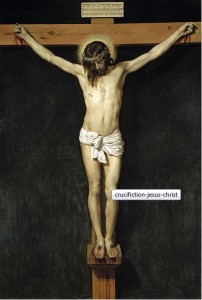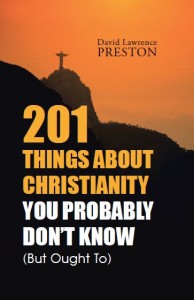Every year on the first Sunday after the first full moon after the Spring Equinox, Christians celebrate Easter, as they have ever since the First Council of Nicaea in 325 CE. Easter is the day on which they believe their Saviour’s body came back to life after suffering a horrendous death, and that he was seen in corporeal form for several weeks before ascending to ‘heaven’ on a cloud. This is the very basis of the Christian religion.
They believe it because some of the Gospels (not all of them, as we’ll see) say it happened. But most Christians have never read the New Testament in full, let alone studied it. They don’t know who wrote it, or when, or how it came to be in its final form. Nor are they aware of the inconsistencies and contradictions it contains.
If they read it, knew its history and thought about it, Christians would realise that the Gospel accounts of the resurrection are just as implausible as a three day old mangled dead body coming back to life would be today!
The church says the contradictions don’t matter, but they would, wouldn’t they? What matters is that believers accept their version of events without question, as a matter of faith, without letting inconvenient facts getting in the way.
But surely for the New Testament stories to have any real value they must be substantially true, which means historically accurate. Otherwise they are on the same par as the Tales of Narnia, Lord of the Rings and other stories written to make a point – thought provoking but works of fiction nonetheless.
What the Gospels Actually Say
The church claims that the entire New Testament was written by people who were all either present at the events they describe or who spoke to eyewitnesses and then presented accurate, unembellished accounts of what they saw or heard.
But this simply isn’t true!
The earliest gospel was written around 70 CE, and most Biblical scholars agree that it is probably the most historically reliable. The second and third were written around 80-90 CE and the fourth between 99-100 CE. All four were unnamed until the late second century when the names Mark, Matthew, Luke and John were ascribed. But they didn’t reach their final form until much later, after they had been translated and mistranslated many times and many additions and redactions had been made.
The longer the period between the actual events, the writing of the manuscript and its reaching its final form, the more embellished became the story.
The earliest New Testament writings are seven of the letters attributed to Paul of Tarsus (Thessalonians 1, Philippians, Philemon, Corinthians 1 and 2, Galatians and Romans). These date from 53-58 CE, a quarter of a century after the crucifixion. The other letters in Paul’s name were written much later after his death, not by him.
Paul had met with at least two of the disciples who knew Yeshua, Peter and James, yet he never claimed a physical resurrection. He wrote that Yeshua appeared in changed form. He wrote (1 Corinthians 15: 3-7): ‘For I handed on to you as of first importance what I in turn had received,’ and went on to report a number of ‘appearances’ to the twelve disciples (strange – after Judas’s suicide there were only supposed to be eleven) and to a wider group of believers.
The First Gospel (later named ‘Mark’) originally ended with the body missing and an angel telling the disciples to return to Galilee where they would see him. They were clearly not expecting this, and fled in terror (Mark 16:5-8). Much later, another section was added by an unknown author (Mark 16:9-19) in which Yeshua ‘appeared’ to them several times and spoke. Nowhere did either author claim that he had risen in bodily form.
The Second and Third Gospels (written around 80-90 CE and subsequently named ‘Matthew’ and ‘Luke’) used the First as a guide and added their resurrection narratives. reported dozens of sightings, although their accounts are remarkably inconsistent. Most of them began and ended mysteriously, for instance, he ‘drew near,’ then ‘disappeared from sight’ like a ghost.
The Third Gospel expanded the story, adding several more appearances in which Yeshua ‘came near’ and ‘stood among them’, showed them his wounds, ate fish, then vanished. Later, he ‘withdrew from them and was carried up to heaven.’ (Luke 24:51) None of these incidents are found in the other Gospels. Moreover, far from fleeing to Galilee, the disciples stayed in Jerusalem and ‘were continually in the temple.’ (Luke 24:50) Perhaps he wasn’t sure of his facts or like any good journalist didn’t want to let the facts get in the way of a good story.
The Acts of the Apostles, written by the same author as the Third Gospel, merely says he ‘presented himself alive’ to the disciples over a forty day period.
By the time the fourth Gospel was written, it was clear that most Jews did not accept Yeshua as the Messiah, and this was reflected in the increasingly exaggerated claims made on his behalf.
Whereas the first three Gospel writers portray Yeshua as what G-d would be like if he took human form, the Fourth Gospel (‘John’) thought he was G-d! This work is regarded by scholars as an abstract work of theology rather than a serious attempt at historical accuracy. Here Yeshua appeared to Mary Magdalene outside the tomb but warned her not to touch him since he had not yet ‘ascended to the Father’. (John 20:17) Later he ‘stood among’ the disciples and invited ‘doubting’ Thomas to touch his wounds. He also he appeared to different disciples on various occasions, in one instance filling their nets full of fish and offering bread and fish for breakfast. On this occasion, in common with most of his ‘appearances’, they did not recognise him immediately.
The Gospels agree on only two details – that the tomb was found empty on the third day after the crucifixion, and that Mary Magdalene was one of those who discovered the empty tomb. None of them say that Yeshua was seen walking out of the tomb, nor do they explain how he was seen fully clothed, considering the burial clothes were left in situ.
What happened to the body?
The Second Gospel has an interesting postscript that illustrates the writers’ dilemma: explaining what happened to Yeshua’s body. According to ‘Matthew’, the Jewish leaders, petrified of what would happen if the word got out that Yeshua had come back to life, paid the soldiers guarding the tomb to spread the story that the disciples came by night and stole the body while they were asleep. ‘This story is still told among the Jews to this day,’ he wrote fifty years after the crucifixion. (Matthew 28:15).
It was normal practice to leave crucified bodies on the crosses until the vultures had torn off the flesh, then remove the bones and dispose of them in sulphur pits outside the city used as a crematorium. It is highly probable that this is what happened to Yeshua’s body too.
But to say so would not have suited the gospel writers. Instead they wrote that Pilate allowed the body to be taken by an influential follower and placed in a sealed tomb. Quite why the Pilate would have allowed this particular troublemaker to be given special treatment is unclear.
When Yeshua died, his disciples were scared and confused, their hopes that the ‘kingdom of God’ was about to appear and reform the world shattered. Then, as the decades rolled by, their successors began to see him as the personification of G-d, and then G-d himself in human form. But how could G-d die? How could they execute G-d as a common criminal and leave his remains to rot in a sulphur pit?
Hence the Easter stories transformed Yeshua’s death and abject defeat into a noble sacrifice, the triumph of life over death, the victory of the Saviour over the Romans and the ultimate vindication despite not being recognised as the Messiah by the Jews. This was their purpose.
A miraculous presence
Apart from the apparent disappearance of the body, the only other historical fact of which we can be sure is that some of Yeshua’s followers believed that they felt the miraculous presence of their dead Master and perhaps saw visions of him. We can’t say exactly what these, but they obviously felt real because many of them suffered and died for it. It’s not unusual for bereaved people today to ‘see’ a departed loved one or ‘feel’ their presence – it happened to me when my father died.
But, in common with Paul, Peter, James and the authors of the First and Second Gospels, I don’t believe his body came back to life in a physical sense. If he had, the events would surely have been mentioned in the historical records of the day, not just the Gospels, and the Jewish population would surely have been won over. But they weren’t.
Diabolical Mimicry
There were many myths concerning a dying and resurrected god-man across the Middle East from the 5th Century BCE onward. In Egypt:
- He was God made flesh, the Son of God.
- His mother was a mortal virgin.
- He was born in a humble cowshed before three shepherds.
- He turned water into wine at a marriage ceremony.
- He rode triumphantly on a donkey while people waved palm leaves to honour him.
- He died, and on the third day rose from the dead and ascended to heaven in glory.
- His followers awaited his return as judge in the last days.
- His death and resurrection were celebrated by a ritual meal of bread and wine which symbolised his body and blood.
This was not Yeshua ben Yosef, the man whose life inspired the Christian religion, but the Egyptian god-man Osiris, five hundred years before his birth! The similarities were so obvious that the Second Century Roman satirist Celsus described Christianity as ‘diabolical mimicry’ and accused Yeshua of ‘having invented his birth from a virgin’. But this is unfair – Yeshua knew nothing about this (and neither did his mother) since the virgin birth stories were invented long after their death.
Of course, the resurrection is not verifiable in a factual/historical sense. You either believe it or you don’t. If you believe, no evidence, no insights, no knowledge, no common sense will shake your belief. That’s the way the human mind works; it’s also the nature of belief.
© David Lawrence Preston, 25.3.2018
Follow me on Facebook and Twitter @David_L_Preston
Hay House/Balboa Press, 2015


Leave a Reply